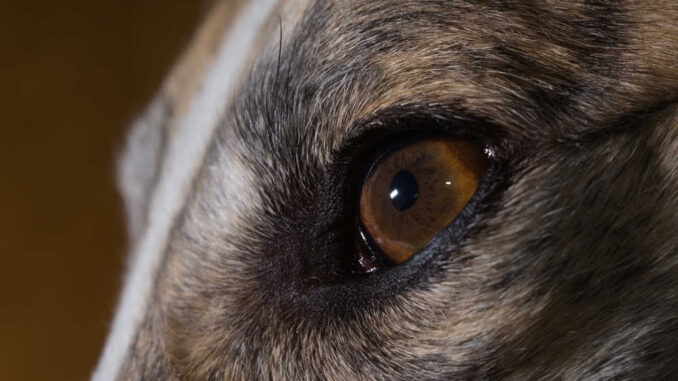
This article was updated on October 21st, 2023

A pet parent recently brought her Boston terrier to my clinic because she noticed a small circular black spot at the bottom of her pup’s eye. It was a few millimeters in diameter and didn’t seem to affect her dog’s vision. After examination, I explained the condition was benign and probably shouldn’t cause any problems.
While this case was benign, others can be quite serious. In this article, we’ll explain the different conditions that lead to brown or black discoloration in the eye, and how they’re treated.
Key highlights:
– Take your dog to the vet if you notice a new black or brown spot on their eye, especially if accompanied by signs of poor vision, eye pain, red, bloodshot, swollen, or bulging eyes, or other indicators of illness.
– Possible causes include nevi, eye cysts, ocular melanosis, pigmentary keratosis, allergy or infection, ocular melanoma (tumor), and Horner’s syndrome.
– While many spots are benign, it’s important to see your vet to rule out the possibility of cancer.
Should I be concerned?
Finding a spot or fleck on your dog’s eye can be shocking. But should you be concerned? Sometimes yes, and sometimes no. There are dogs born with spots of black or brown hyperpigmentation in their eyes. However, these dark areas could also point toward cancer or other serious conditions like corneal ulcers or glaucoma.
How do you tell the difference? Take your dog to the vet if you observe other symptoms including:
- Bumping into furniture or walls
- Rubbing the eyes
- Squinting or sensitivity to light
- Red, bloodshot, or swollen eyes
- Anxiety or hesitation in unfamiliar surroundings
- Bulging eyes
- Other signs of discomfort or illness
Note that many eye conditions that cause black or brown eye spots share similar symptoms, so it can be challenging to tell the difference between harmless conditions and serious health threats. If you notice new spots in your dog’s eye(s), you should contact your veterinarian and discuss your findings.
7 frequent causes of brown or black spots (with pictures)
We have listed below the most common causes of brown or black spots in dogs’ eyes:
1. Nevi (iris freckles)
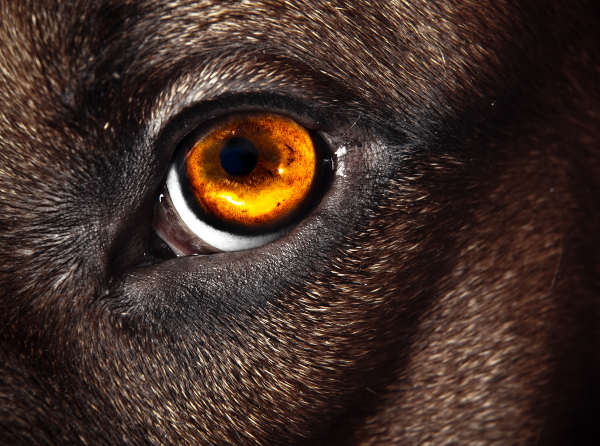
Some dogs can develop areas with increased pigment in the iris. They can be caused by UV light exposure or a genetic predisposition. Usually, these freckles are benign.
If they grow larger, they may affect your pup’s eye or vision. Smaller nevi can increase in size and become a flat or rounded spot known as a nevus. Occasionally, nevi become tumors.
Treatment for nevi is usually not necessary. However, you should monitor your pooch for any changes. Tell your veterinarian about any growth in size, loss of vision for your dog, or other concerning symptoms.
2. Eye cysts
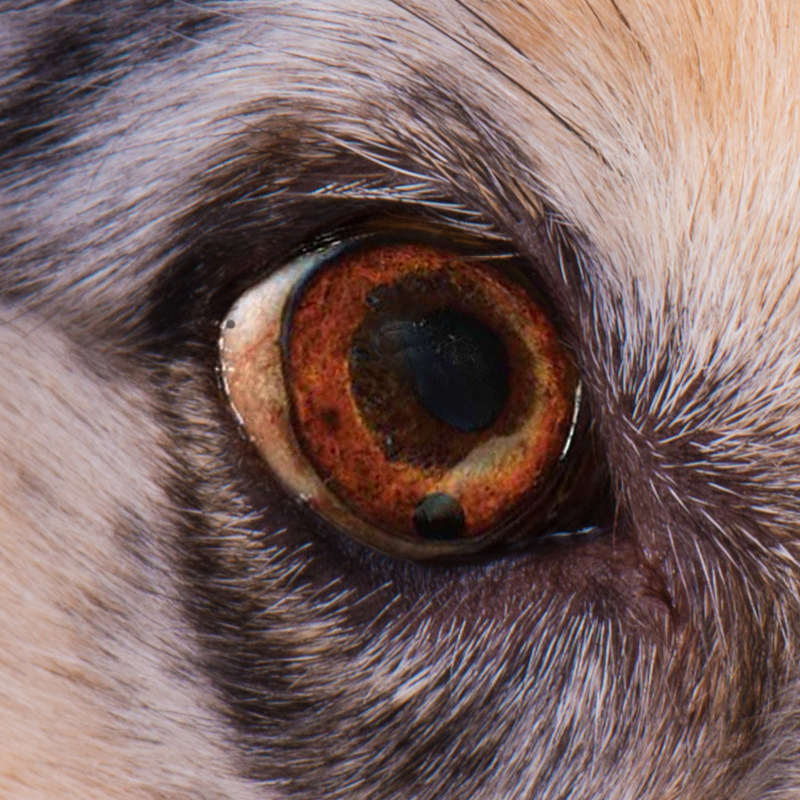
Eye cysts may be congenital or arise as a result of trauma or inflammation. They’re black, fluid-filled discs that are often only a few millimeters in diameter. Iris cysts do not usually affect your dog’s vision and tend to be painless.
As with nevi, iris cysts rarely require treatment. If the discs affect your dog’s vision, they can be surgically deflated or aspirated. Learn more about eye cysts in dogs.
3. Ocular melanosis
The picture below shows brown pigmentation in the sclera of a dog’s eye from deposits of melanin pigment. The spots may be caused by ocular melanosis.
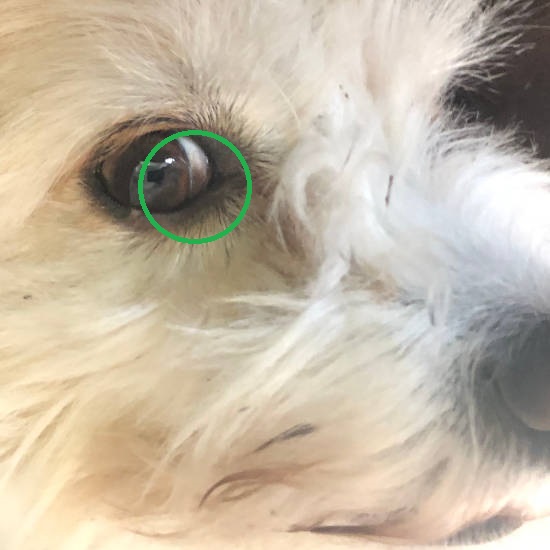
Certain breeds, including Cairn terriers and Boxers, can develop a build-up of melanocytes in some layers of the eye, such as the iris and sclera. The cells clog the normal drainage system in the eye, so the intraocular pressure increases. As a result, secondary glaucoma may develop. However, as long as the dog is not showing other signs of illness, there is no need to panic.
Simply let your veterinarian know about the brown discoloration at your next visit and monitor it. You should reach out to your veterinarian soon however, if you notice any other signs of ocular melanosis, including:
- Bloodshot eyes
- Bulging eyes
- Cloudy cornea
- Excessive tearing
- Light sensitivity
- Loss of appetite or any other signs of illness
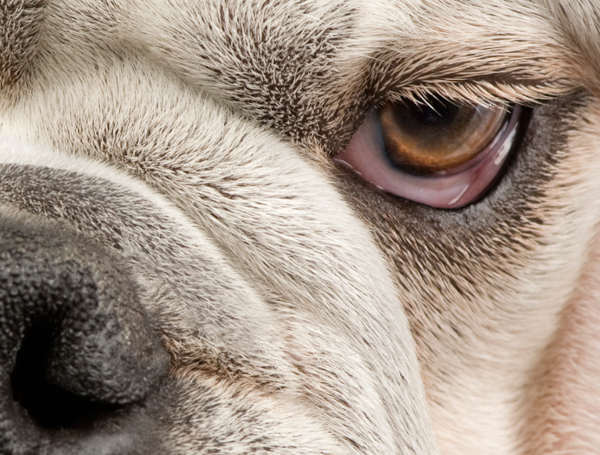
There is no cure for ocular melanosis. Medical management with anti-inflammatory drugs and analgesics may help reduce pain and inflammation. In some cases, laser surgery by a specialist may help decrease the production of aqueous fluid in the eye.
4. Pigmentary keratitis
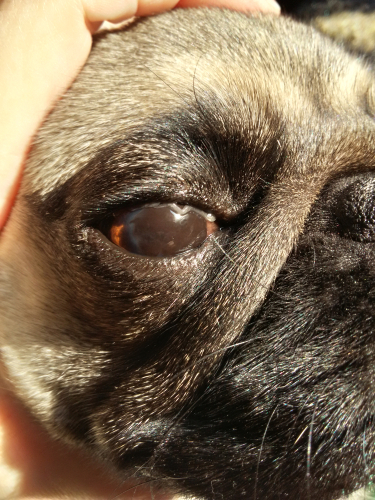
Chronic eye inflammation can cause brownish-black spots in the eye from a deposit of melanin granules. Most commonly seen in brachycephalic breeds, this condition is often linked to dry eyes. Signs of pigmentary keratitis include:
- Flat brown spot in the cornea
- Bloodshot white of the eye
- Reddened conjunctival membranes
- Eye discharge
Treatment for pigmentary keratitis is directed at the underlying cause and may include artificial tears or surgical repair of eyelid abnormalities. The spots are usually not reversible, but they may fade over time.
5. Allergy/Infection
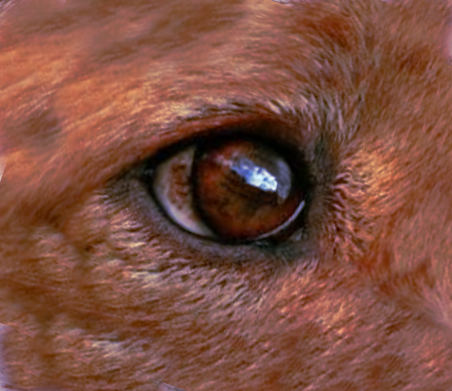
When some dogs have an allergic reaction to environmental or food allergens, they develop brown spots on their eyes from the inflammation. This symptom may also be present with certain eye infections such as uveitis. Other symptoms you may notice with eye allergies or infections include:
- Reddened or bloodshot sclera
- Watery eye
- Discharge
- Blinking or squinting
- Pawing at the face/eye
To treat allergies, your veterinarian will recommend lifestyle changes to avoid the allergen if possible. This may involve feeding a hypoallergenic diet, changing your dog’s bedding, and doing a deep cleaning of the house. The doctor will also prescribe antihistamines and possibly steroidal eye drops to reduce inflammation. If your pooch has an eye infection, your vet will treat it with oral or ophthalmic antibiotics. Learn more about the differences between eye infections and allergies.
6. Ocular melanoma/tumor
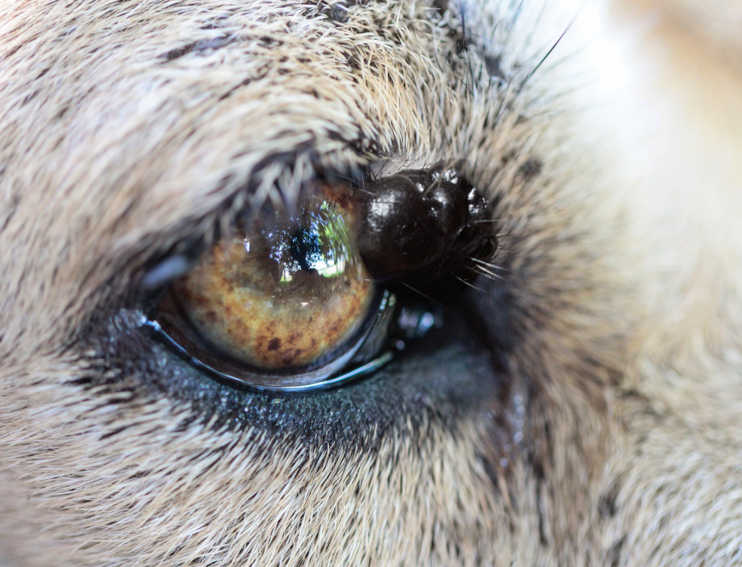

When melanocytes grow uncontrollably in the uvea or limbus, they can clump together in a mass of cells. Although the growths are often benign, they cause considerable pain and inflammation. Long term, melanomas can lead to glaucoma, retinal detachment, and cataracts.
Symptoms include:
- Brown or black spots on the iris that may be raised or flat
- Intraocular bleeding
- Dark mass inside the eye that protrudes through the pupil
- Redness
- Rubbing the eye
- Excessive tearing
Learn more about melanomas in dogs.
7. Horner’s Syndrome
With Horner’s syndrome, the sympathetic nerves to one eye suddenly stop functioning properly. As a result, dogs will have symptoms in the affected eye:
- Drooping upper eyelid
- The pupil is constricted/small
- Eye appears sunken
- The third eyelid is red and may be elevated/raised
Many times, Horner’s syndrome in dogs is idiopathic, meaning it has no known cause. It tends to resolve in 6-8 weeks. If the condition is triggered by an infection, injury, or mass and is characterized as preganglionic, the prognosis is guarded.
There is no cure for idiopathic Horner’s, but if there’s an identifiable cause, your veterinarian will treat the underlying condition.
Can new spots on my dog’s eyes be cancer?
Brown or black spots can be a sign of a cancerous tumor. When melanocytes clump together in your dog’s uveal tract, the growth is usually benign. However, the growths occasionally become malignant if they’re left alone. If you notice new brown or black spots in your pup’s eye, you should consult with your veterinarian to rule out the possibility of cancer.
Learn more about Spots in Dog’s Eyes (with pictures and veterinarian advice).
Disclaimer: This website's content is not a substitute for veterinary care. Always consult with your veterinarian for healthcare decisions. Read More.


Be the first to comment